The well on the site helps to solve the issue of autonomous water supply. But without special equipment, it is impossible to raise the liquid to the surface. And you don't want to buy expensive automatic devices if the dacha is visited from time to time, right?
A hand pump for a well of domestic or foreign production will be much cheaper. It is not difficult to install it, and it can work even in the absence of a central electrical supply on the site.
But which option is better to choose? We will help you deal with these issues - our publication discusses the design features of the most popular types of manual pumps, their capabilities, the main pros and cons. We also provided recommendations for choosing the right equipment option.
The content of the article:
- Features of handheld equipment
-
Varieties of hand pumps
- View # 1 - vane units
- View # 2 - piston type pumps
- View # 3 - rod (rod) devices
- Type # 4 - membrane equipment
- Recommendations for choosing a hand pump
- Conclusions and useful video on the topic
Features of handheld equipment
The hand pump allows you to pump liquid from well equipped on the site, to the point of selection, with little effort. The flow rate here is much lower than in automatic devices. But pumping a bucket of water by hand is not difficult - even a teenager can cope with this task.
However, linkages have a number of significant advantages.
Among the key positions are the following:
- autonomy - the device can be used where there is no electrical network, or the cost of electricity is too high, and it is not economically profitable to connect powerful equipment;
- small material purchase costs - a manual unit is much cheaper than an automatic one and there is not always a real need to pay a significant amount of money for equipment that will not be operated in a constant mode;
- versatility - hand pumps on the market are presented in a wide range, you can choose a suitable device for both deep and shallow wells;
- maintainability - if any nodes of the lever models fail, they are very easy and quick to replace;
- easy installation - installation does not require specialized knowledge and is carried out without the use of a specific, expensive tool:
- elementary use - in order for the pump to start supplying water, you only need to raise and lower the handle several times, even a child, woman or pensioner can easily cope with this task.
The equipment has only two drawbacks. The first is the physical effort that is required to obtain fluid for drinking or watering. In this plan automatic pumpspumping water out of a well without direct human intervention win.
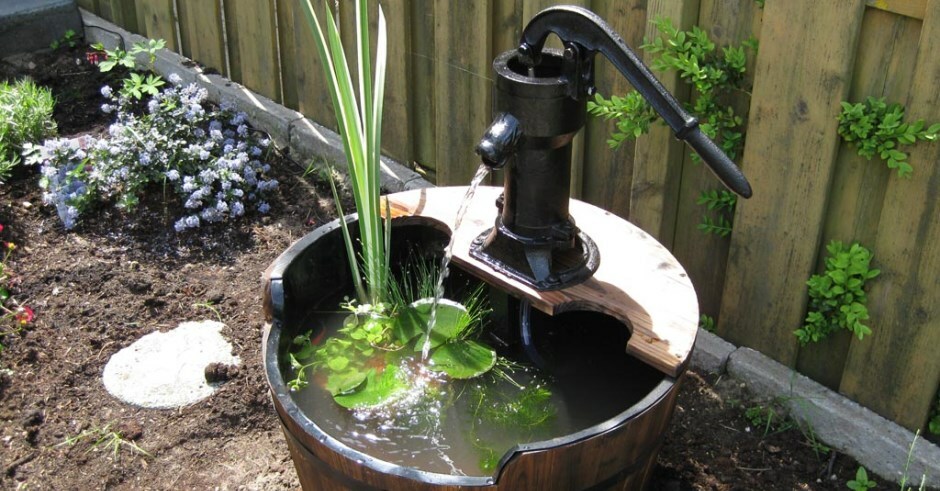
An aesthetically attractive pump with a lever mechanism can be not only a practical and convenient device for supplying water, but also an original decoration of a summer cottage
The second is a low productivity in comparison with automatic units.
However, this cannot be considered a full-fledged disadvantage. After all, such models are intended for installation in places where there is no need for water constantly flowing from the tap or an uninterrupted supply is simply impossible to organize physically.
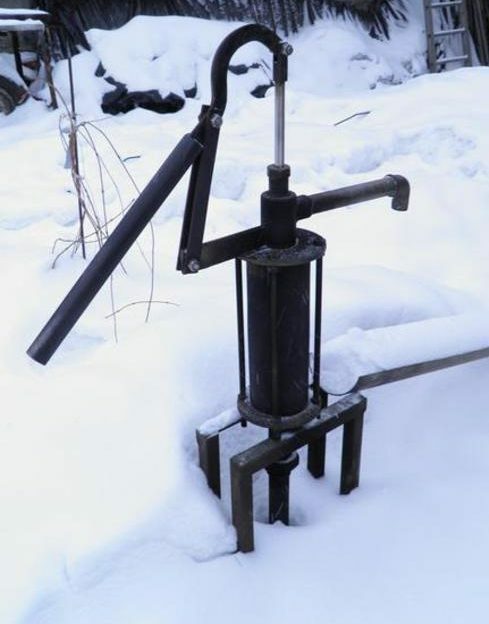
Hand pumps with plastic housing are only suitable for summer use. Cast iron and metal units operate normally all year round. They need insulation, subject to a sharp change in temperature conditions
Typically, hand pumps are used in suburban areas visited only in summer and in places where there are problems with the constant supply of electricity.
Also, manual models are used as an accompanying option for water supply. So, it will be quite difficult to provide the necessary amount of water to the vegetable garden every day. A hand pump will help you cope with this task, and without the extra cost of paying for electricity.
Varieties of hand pumps
Manual water pumping equipment on the market is presented in a wide variety of options.
Well owners are offered the following types of products:
- vane;
- piston;
- rod;
- membrane.
Each species has features that determine the area of maximum efficient use. Regardless of the design and principle of operation, all devices demonstrate approximately the same performance.
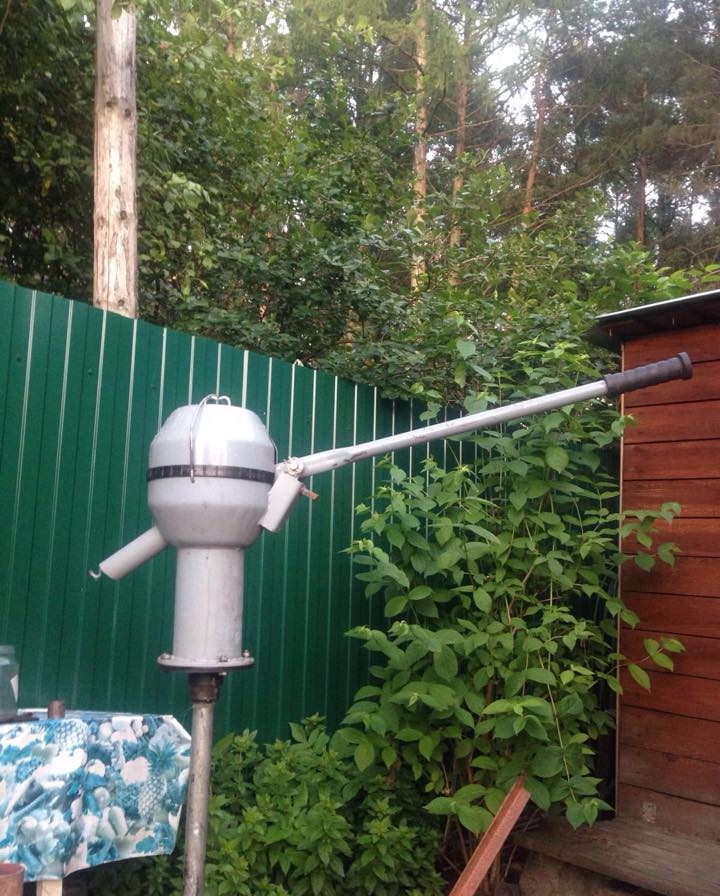
Plastic pumps are not very durable. Under the influence of sunlight or sudden temperature changes, the case may crack and burst. The equipment will have to be hastily changed, and this is inevitable material costs.
In one full cycle of reciprocating motion, about a liter of fluid will be obtained from the well. In a minute in this way, you can collect from 20 to 40 liters of water. A more accurate figure depends on how often the user can raise / lower the lever-handle.
View # 1 - vane units
The hand vane pump is a compact device for pumping water from underground sources depth of 5-7 meters. Small dimensions allow the device to be used for technical purposes in factories, warehouses, bases and other areas where it is not possible to mount more powerful and dimensional equipment.
Structurally, the product consists of a body with a pressure head and a suction branch. The impeller with blades is fixed on the shaft, which is firmly connected to the handle of the device. The upper compartment of the device maintains a constant volume even if the position of the impeller is changed.
The lower part of the working chamber of the pump is divided into two parts by special bridges. Two valves are located on the pump blades, and two more, working in opposition to them, are located at the entrance to the lower chamber.
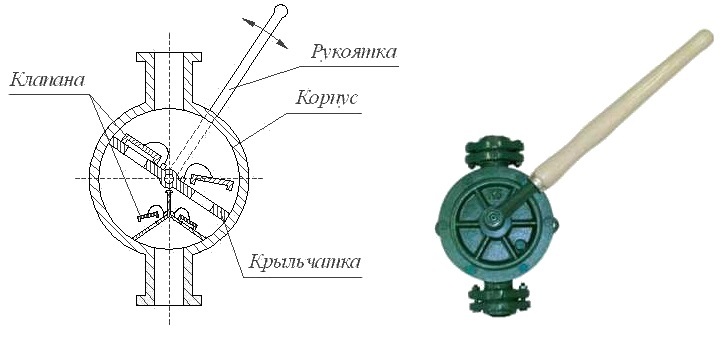
The branch pipes are connected to the metal body by means of a flange or coupling. Through the suction outlet, water from the well enters the system. The discharge part is connected to the parsing point
In the process of acting on the user's handle, the impeller begins to rotate. In the working chamber, alternating zones of increased pressure and discharge are formed. The liquid is sucked in through the inlet and pushed vigorously through the discharge. Pump valves ensure the movement of water along the communication lines in only one direction.
Vane-type hand pumps cope with pumping rather viscous liquids, but they do not tolerate contaminated liquid well. Not suitable for transporting water containing fragments of liquid fuels, alcohols, paraffin, edible oils and any abrasive materials. Works well with clean shallow wells.
They can often be used in basements where it is impossible to place more powerful and bulky equipment. At a budget price, they are sold in an anodized metal case.
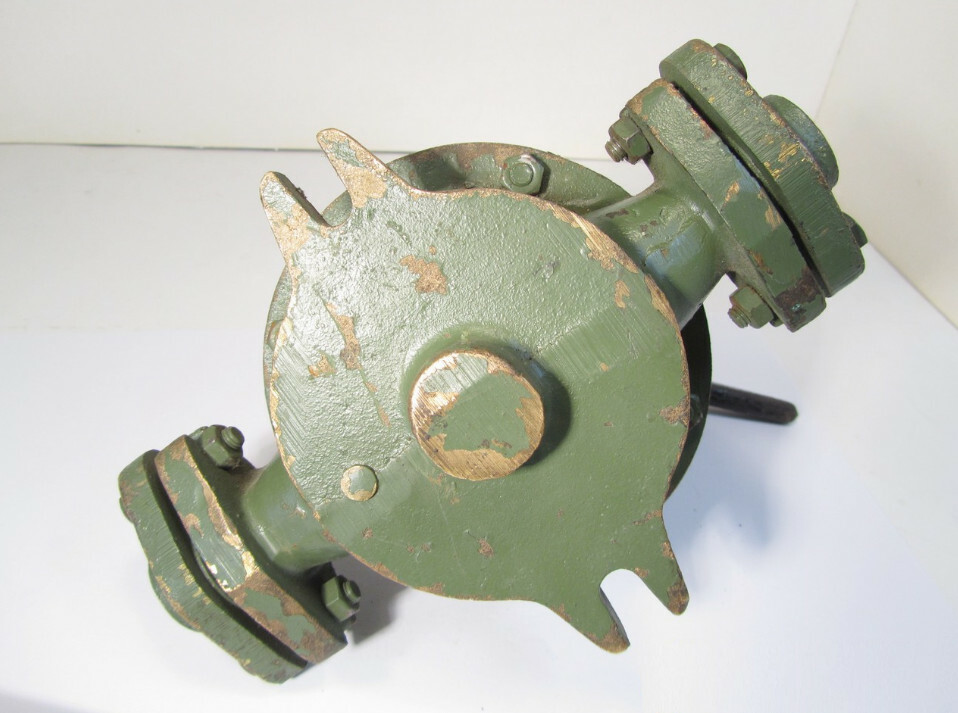
Bronze products are more expensive, but they are distinguished by exceptional corrosion resistance, do not lose their physical characteristics during operation and are not subject to deformation under the influence of pumped liquids
Among the models of foreign manufacturers are popular German K1 and K2 with brass valves and blades. Russian analogue of RK2 sold at a higher price, but equipped with a vane mechanism made of metal, prone to corrosive manifestations.
Pluses of vane pumps: compact size, ability to pump viscous liquids.
Among the minuses: low productivity, high demands on water purity, work in shallow wells.
View # 2 - piston type pumps
Piston devices are very popular. Structurally, they consist of a cylindrical body made of food grade stainless steel. The piston moves inside, by means of a rod attached to the rocker arm.
Elastic PTFE seals ensure a tight fit of the piston disc to the walls. Above are spherical check valves.
Pumps of this type create inlet pressure. Placed 1 meter above ground level. They are mounted on the upper part of the casing in such a way that the system check valve is located at the outlet of the riser pipe immersed in the hole.
They are used where the water mirror is located high. Water is extracted from wells up to 10 meters. From deeper sources, they cannot raise liquid to the surface. Much physical effort is not required to press the lever mechanism.
In the process of the forward movement of the piston, the valve is lowered and prevents the outflow of fluid in the opposite direction. Pressurized water opens the built-in valves and rises above the surface of the piston disc.
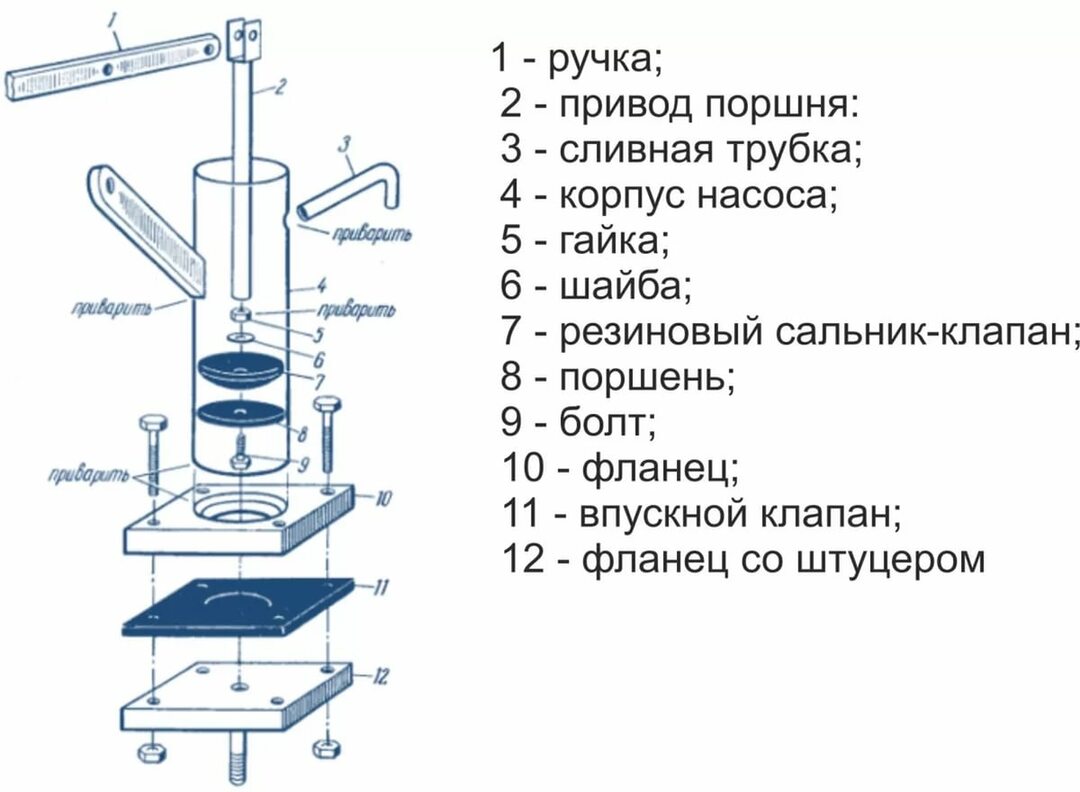
Over time, pump seals and gaskets wear out and do not provide the desired level of tightness. This significantly reduces the performance of the equipment. To avoid such a situation, the device needs to be serviced and defective components must be replaced.
During the reciprocating movement of the piston, the valve is lowered and prevents the outflow of fluid in the opposite direction. Pressurized water opens the built-in valves and rises above the surface of the piston disc. During the reverse stroke, the disc valves close, preventing water from flowing downward.
The air pumped into the system pushes the fluid upward under pressure and as a result it is poured out through the pump outlet drain pipe.
In the rating of the best-selling piston models, the top positions are occupied by devices made of steel with galvanized bolts from Russian manufacturer Watergood. Products of foreign brands are less popular.
Pluses of piston pumps: pumping of both clean and muddy water with sand, suitability for work with light oil products, acids, solvents, alcohols.
Another plus lies in the simplicity of the design - for example, a piston-type pump can make at home.
The main disadvantages: some models require insulation for the winter, since they cannot be used if the ambient temperature drops below +1 ° C. Usually this information is indicated on the manufacturer's website and in the accompanying technical documentation of the device.
View # 3 - rod (rod) devices
Sucker rod hand pumps are sometimes called rod pumps. They are used where water occurs at a depth of 12-30 meters. For all other manual models, this is an overwhelming task.
By design, the devices are slightly similar to piston units. As the main working unit, a cylinder and a piston with an elongated end are used here. The pump part of the device is located in the aquifer.
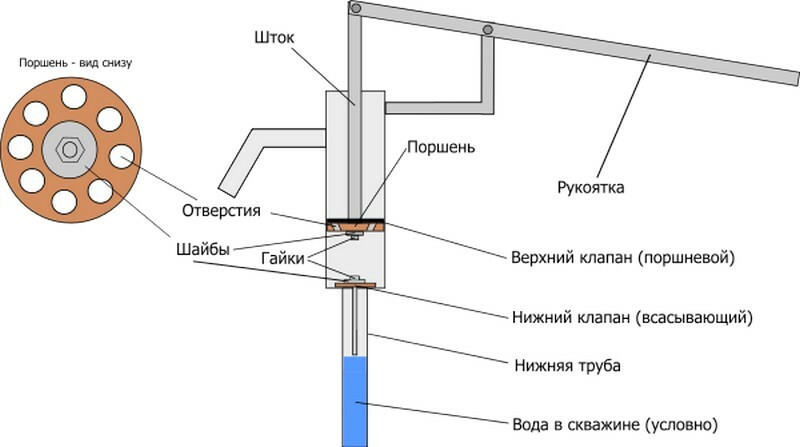
It is important that the bottom valve of the rod pump is always in the water. During the installation process, it is necessary to take this moment into account and make sure that during pumping out the structure does not turn out to be higher than the real level of the water surface.
Rod-type equipment is installed directly into the well. The rod part is immersed in water to a depth of about 1 meter.
The pumping of water begins when a person sets the lever device in motion. The piston is lowered and the bottom valve is closed. The resulting pressure opens the top valve and fluid moves into the space above the cylinder.
During the lifting of the piston element, water closes the upper valve, and the vacuum created under the piston opens the lower valve to suck in water.
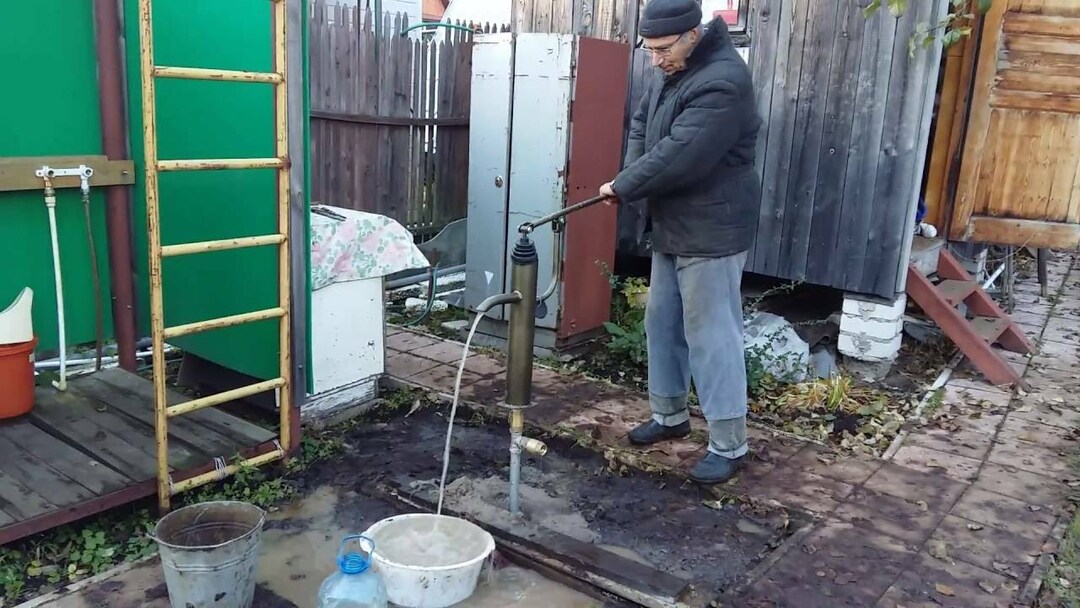
An indispensable condition for the installation of rod-type equipment is an absolutely straight vertical borehole without bends. On sloping terrain, the use of such devices is unacceptable.
It is most important to use sucker rod pumps in conditions where the water is too deep for the installation of an external electrical appliance, the diameter of the well does not allow the installation of an automatic pump or there is no possibility of connecting to electrical network. In all other situations, spending money on equipment is impractical.
The main advantage of sucker rod pumps is the lifting of liquid from great depths. A compact rod-type pump for wells up to 15 m deep can be made at home. We recommend that you familiarize yourself with the detailed manufacturing instructions homemade pumps from scrap materials.
The disadvantages of purchased models are the complexity of the installation, the cumbersome structure, the great effort required for pumping, inability to use the unit in wells located on bevels or with internal curvature, high risk of breakage rods.
Type # 4 - membrane equipment
Manual diaphragm or diaphragm pumps are very durable. They can equally successfully pump clean / polluted domestic water and diesel fuel containing impurities. Even in the presence of a large amount of fine sand particles and abrasive elements in the liquid, all units work flawlessly.
Ball valves do not occupy a fixed place, do not rub against each other, but constantly roll over. This promotes self-cleaning and eliminates the risk of jamming.
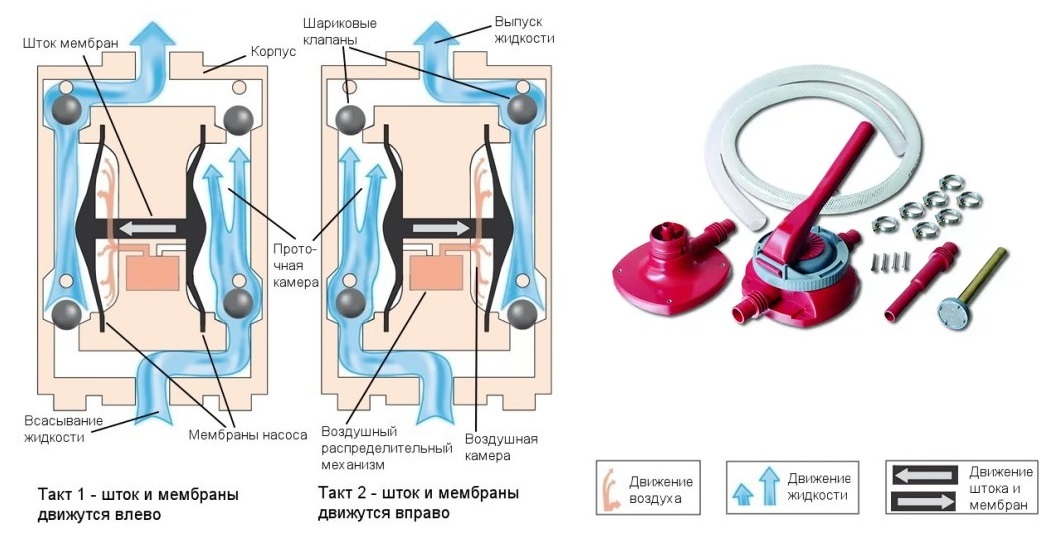
The working position of the membrane unit is vertical, handle down. The device is attached to the wall through the narrowed parts on the sides of the case. At the top there is a discharge nozzle, at the bottom of the suction element. In case of violation of the integrity of the membrane, it must be replaced
The round body of the devices is made of durable plastic or cast from high quality cast iron. Diaphragms and valves are made of oil and petrol resistant rubber. The equipment serves for years and does not fail. Suitable for use in shallow wells only.
The device can be used not only for pumping water of any quality, but also for draining waste or rainwater from cellars, basements, trenches and other areas that have been flooded.
Among buyers, models from Danish concern Grundfos and Taiwanese pumps Ampika. They are sold at the best price.
Among the advantages are wear resistance, undemanding to the quality of pumped water, optimal weight, loyal cost, durability.
The main disadvantage is the ability to work in shallow wells (up to 6 meters).
Recommendations for choosing a hand pump
Choosing a hand pump, you must first of all focus on the depth of the well. If it is from 5 to 7 meters, all types of portable pump devices will cope with the task. For springs where the water mirror is at a height of up to 10 meters, any lever equipment, except for vane equipment, is suitable.
Only a hand-held rod device can lift liquid to the surface from a depth of up to 30 meters. But for this, the well should not have bevels or bends.
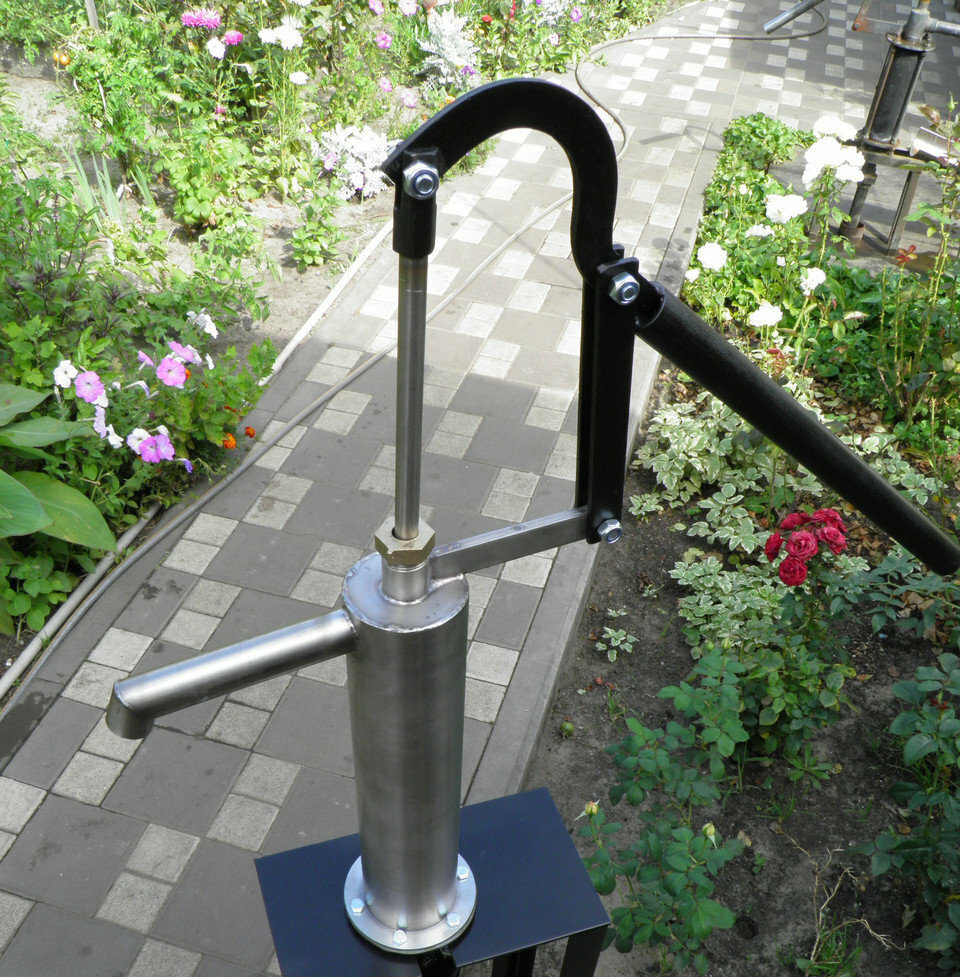
All types of handheld devices work correctly with wells with a diameter of 4 inches or more. The user selects and installs the model that he likes visually more and suits the cost
The weight of the linkage equipment ranges from 4 to 130 kg. This parameter is important at the time of transportation. Lightweight products up to 15 kg can be delivered to the installation site by yourself. Heavier models will have to be transported by car and use the services of hired workers for loading / unloading.
Problems often arise when installing heavy hand pumps. Usually, the owner will require third-party assistance in carrying and installing the appliance. It is advisable to think about this in advance and invite a master or use the services of someone from relatives, friends or acquaintances.
Another important element when choosing a model is water quality. Vane units in this regard are very demanding and cannot cope with pumping liquid containing sand and impurities.
If there is a problem with the purity of the water on the site, you should prefer piston, rod or diaphragm pumps. They will perform the task normally and will not fail after passing through the system of fine abrasive particles.
Do you need a functional pump for pumping out dirty water, but the manual version is not suitable? We recommend that you familiarize yourself with the best automatic modelspresented on the market and selection rules.
If the equipment is needed only for operation in the summer, it is worth considering pumps with a plastic casing. They are sold at a lower price, are lightweight and are considered a budget option. But they cannot withstand serious workloads and often fail without even working for one season.
Products made from thin-walled food grade steel are considered to be more durable than plastic ones. Cast iron and bronze devices have a maximum period of use. The high price in them is compensated by a long operating period, reliability and resistance to manifestations of the external environment. All metal units are suitable for year-round use.
The appearance of the pump also matters. It is desirable that it blend harmoniously with all other elements on the site and does not spoil the surrounding landscape. Selected manufacturers produce hand pumps with eye-catching handles and stylish taps. Such products are more expensive, but fully justify the cost, turning from a familiar element into a decorative object.
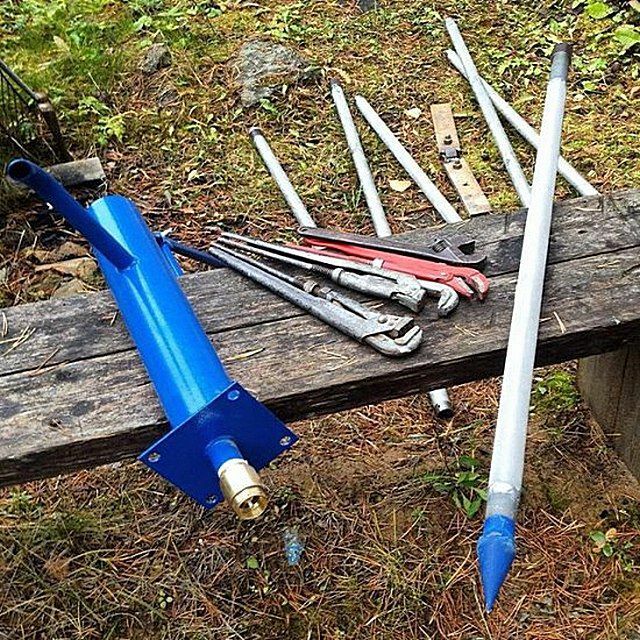
When there are several sources of water on the site, it makes sense to buy the pump that is as light and easy to carry as possible. It can be installed where the liquid is required at a certain moment, and then moved to another point
In order for the pump to always work correctly and not break down, you need to take care of it, clean individual units and lubricate them with special means. Some models have a self-cleaning system. Additional maintenance is not required for such devices.
If you plan to spend a lot of time in the country, then you cannot do without automation of the water supply system. In this case, we recommend that you familiarize yourself with rating of pumping stations, which are in demand among buyers, and the rules for choosing the best.
Conclusions and useful video on the topic
Technical characteristics and features of the piston hand pump with cast iron body.
The principle of operation of the mechanism of a piston-type hand pump.
How a sucker rod pump works. A real user demonstrates the process of producing water from a well.
Using a hand pump is a good way out for owners of summer cottages or country houses for temporary residence. The equipment is inexpensive, easy to install, does not require an electrical connection, and supplies water from sources 5 to 30 meters deep.
The lever pump works in all weather conditions and withstands heavy use. It can be used to organize an additional water distribution point in areas where the main water supply is located far from irrigation areas.
Do you use a manual pump at your dacha? Show your pump model in the comments, share your impression of using it. Or are you just looking at this type of pumping equipment, evaluating its pros and cons? If you have any questions about choosing the right type of hand pump, do not hesitate to ask our experts and other site visitors for advice. The feedback form is located at the bottom of this publication.


